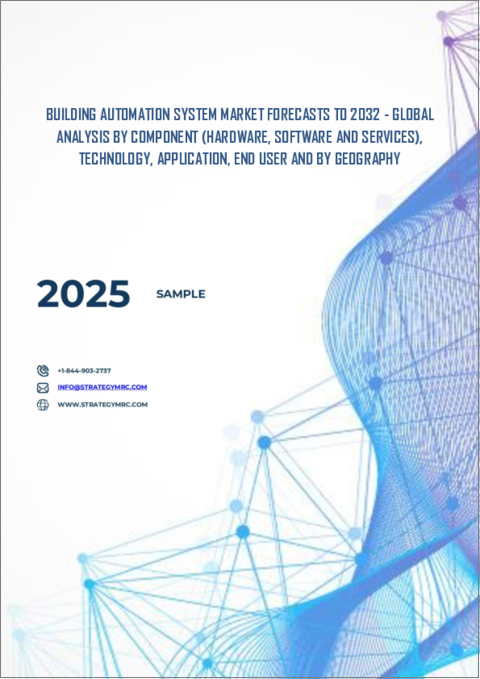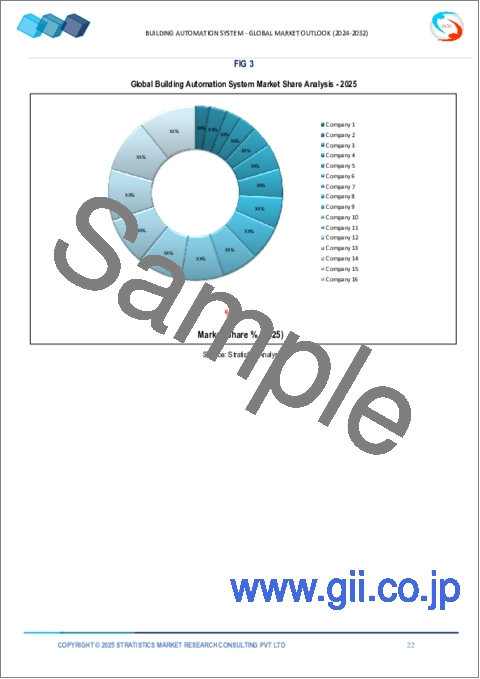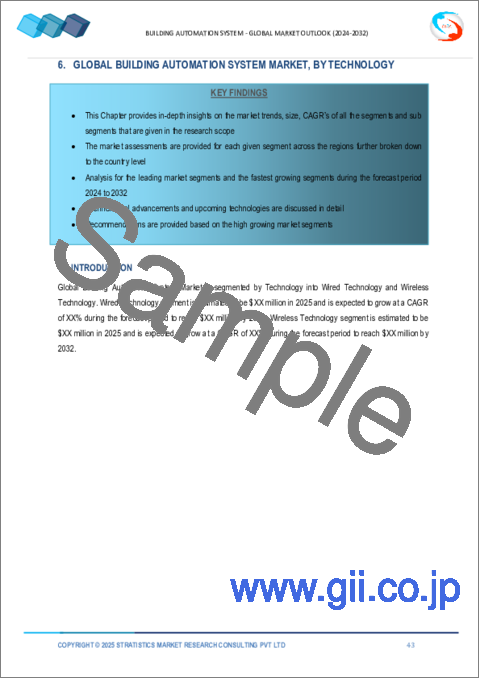|
|
市場調査レポート
商品コード
1503334
ビルディングオートメーションシステム市場の2030年までの予測:コンポーネント別、技術別、用途別、エンドユーザー別、地域別の世界分析Building Automation System Market Forecasts to 2030 - Global Analysis By Component (Hardware, Software and Services), Technology, Application, End User and By Geography |
||||||
カスタマイズ可能
|
|||||||
| ビルディングオートメーションシステム市場の2030年までの予測:コンポーネント別、技術別、用途別、エンドユーザー別、地域別の世界分析 |
|
出版日: 2024年06月06日
発行: Stratistics Market Research Consulting
ページ情報: 英文 200+ Pages
納期: 2~3営業日
|
- 全表示
- 概要
- 図表
- 目次
Stratistics MRCによると、世界のビルディングオートメーションシステム市場は2024年に889億米ドルを占め、予測期間中のCAGRは9.8%で成長し、2030年には1,559億米ドルに達する見込みです。
ビルディングオートメーションシステム(BAS)は、HVAC、照明、セキュリティ、防災など、ビルの機械・電気・配管(MEP)システムを監視・管理する集中制御システムです。これらのシステムを統合することで、BASは運用効率を高め、エネルギー消費を削減し、居住者の快適性を向上させる。センサー、コントローラー、ソフトウェアを使用してプロセスを自動化し、最適なパフォーマンスと異常への迅速な対応を実現します。BASは近代的なビルにとって不可欠であり、リモートアクセスやデータ分析を提供してメンテナンスや意思決定を促進し、最終的には持続可能でスマートなビル管理に貢献します。
シスコのAnnual Internet Reportによると、2018年の184億台から、来年には300億台近いネットワーク接続デバイスと接続が存在する見込みです。
スマートビルとIoT統合への需要の高まり
効率性と機能性を向上させる統合技術を備えたスマートビルディングのコンセプトが支持を集めています。BASは、さまざまなシステムを自動化・最適化することで、こうしたスマート環境を構築する上で中心的な役割を果たしています。モノのインターネット(IoT)は、ビル内のデバイスのシームレスな接続を可能にし、リアルタイムのデータ収集と自動制御を可能にします。BASはIoTを活用してこれらのデバイスを統合し、集中管理を行う。
実装の複雑さと相互運用性の課題
BASは、センサー、コントローラー、ソフトウェアなど、さまざまなメーカーのさまざまなコンポーネントを統合する必要があります。この統合プロセスは複雑で、特定のビル要件に基づいてカスタマイズする必要があるため、設置に時間がかかり、コストが高くなる可能性があります。さらに、異なるBASコンポーネント間で標準化された通信プロトコルがないため、互換性の問題が生じ、シームレスなシステム運用が妨げられる可能性があります。これは、アップグレード時に既存のBASインフラに新技術を統合する際に、特に課題となります。
エネルギー効率と持続可能性への関心の高まり
ビルは主要なエネルギー消費者であり、BASはエネルギー消費を削減するための強力なツールを提供します。HVAC、照明、その他のシステムを自動化することで、BASはエネルギー代を大幅に削減し、持続可能性の目標に貢献することができます。環境問題への関心の高まりとエネルギー規制の厳格化により、ビル所有者と運営者は、効率的なエネルギー管理のためにBASを採用する方向に向かっています。
限られた認識と長期的なROIの認識
多くの潜在顧客は、特に住宅セクターにおいて、BASの機能とその利点を十分に認識していない可能性があります。この認識不足は、ビル管理の意思決定をする際にBASを考慮しない可能性があるため、市場の成長を妨げます。さらに、限られた知識はBASに対する誤解を招く可能性があります。BASを大規模な商業ビルだけのものだと認識している人もいるかもしれず、家庭や小規模施設における潜在的価値を軽視していることが市場成長の妨げになっています。
COVID-19の影響
COVID-19の流行はビルディングオートメーションシステム(BAS)市場に大きな影響を与え、建物内の健康と安全対策に対する需要の増加により市場の成長を加速させました。空気環境の改善、非接触操作、遠隔監視のニーズが、高度なBAS技術の採用を促進しました。換気の強化、居住モニタリング、タッチレス制御は、安全な環境を維持するために不可欠となった。市場では、遠隔作業をサポートし、衛生ガイドラインの遵守を保証するスマートで適応性の高いシステムへのシフトが見られました。
予測期間中、有線技術セグメントが最大となる見込み
有線技術は、統合システム向けに信頼性が高く安全な通信を提供するため、予測期間中に最大となる見込みです。その堅牢性は、HVAC、照明、セキュリティのような重要なビル機能にとって極めて重要な一貫したデータ伝送を保証します。しかし、有線技術はコストが高く柔軟性に欠けるため、古い建物の改修や既存システムの拡張には課題があります。有線技術には安定性とセキュリティ上の利点がある一方で、無線技術やIoT技術の台頭により、市場はより柔軟でコスト効率に優れ、拡張性の高いソリューションへと徐々にシフトしています。
防火システム分野は予測期間中に最も高いCAGRが見込まれる
最新のBASでは、建物の総合的な安全性を確保するために、火災検知、警報、消火システムが組み込まれることが多くなっているため、防火システム分野は予測期間中に最も高いCAGRを示すと予想されます。BASに防火システムを統合することで、応答時間の短縮、メンテナンスの合理化、集中制御が可能になり、全体的な安全性と法規制への準拠が向上します。このような融合により、高度なBAS技術の採用が促進され、市場の成長が促進されます。ビルが安全性とスマートな管理を優先するにつれて、防火を他のビル機能とシームレスに統合する結束システムに対する需要が高まり、BAS市場の拡大を後押ししています。
最大のシェアを占める地域
予測期間中、欧州が最大の市場シェアを占めると予測されています。これは、セキュリティに対する懸念の高まりが、製品革新や買収を通じてビル向けの新たなセキュリティ製品を提供する企業の原動力となっているためです。例えば、2022年10月、ASSA ABLOYは、戸建ておよび集合住宅向けの高品質IPドアインターホンのドイツメーカーであるBird Home Automation GmbHを買収しました。この買収により、ASSA ABLOYは住宅分野での成長をさらに加速させています。
CAGRが最も高い地域:
アジア太平洋地域は、急速な都市化とインフラ整備の進展により、予測期間中最も高いCAGRを維持すると予測されています。同地域では、建物のエネルギー効率に関する規制と政策がますます厳しくなっているため、ビルオートメーションの需要が大半を占めています。公共インフラや建物における設備管理の需要が高まっており、自動化ソリューションの成長をさらに後押ししています。
無料カスタマイズサービス:
本レポートをご購読のお客様には、以下の無料カスタマイズオプションのいずれかをご利用いただけます:
- 企業プロファイル
- 追加市場プレーヤーの包括的プロファイリング(3社まで)
- 主要企業のSWOT分析(3社まで)
- 地域セグメンテーション
- 顧客の関心に応じた主要国の市場推計・予測・CAGR(注:フィージビリティチェックによる)
- 競合ベンチマーキング
- 製品ポートフォリオ、地理的プレゼンス、戦略的提携に基づく主要企業のベンチマーキング
目次
第1章 エグゼクティブサマリー
第2章 序文
- 概要
- ステークホルダー
- 調査範囲
- 調査手法
- データマイニング
- データ分析
- データ検証
- 調査アプローチ
- 調査情報源
- 1次調査情報源
- 2次調査情報源
- 前提条件
第3章 市場動向分析
- 促進要因
- 抑制要因
- 機会
- 脅威
- 技術分析
- 用途分析
- エンドユーザー分析
- 新興市場
- COVID-19の影響
第4章 ポーターのファイブフォース分析
- 供給企業の交渉力
- 買い手の交渉力
- 代替品の脅威
- 新規参入業者の脅威
- 競争企業間の敵対関係
第5章 世界のビルディングオートメーションシステム市場:コンポーネント別
- ハードウェア
- コントローラー
- センサー
- アクチュエータ
- ゲートウェイ
- ソフトウェア
- 施設管理ソフトウェア
- セキュリティおよびアクセス制御ソフトウェア
- エネルギー管理ソフトウェア
- サービス
- メンテナンスとサポート
- インストールと統合
- コンサルティングサービス
第6章 世界のビルディングオートメーションシステム市場:技術別
- 有線テクノロジー
- LonWorks
- BACnet
- Modbus
- KNX
- ワイヤレステクノロジー
- ZigBee
- Z-Wave
- Wi-Fi
- Bluetooth
第7章 世界のビルディングオートメーションシステム市場:アプリケーション別
- 照明制御
- 暖房、換気、空調(HVAC)制御
- セキュリティとアクセス制御
- 防火システム
- ビルエネルギー管理
- その他のアプリケーション
第8章 世界のビルディングオートメーションシステム市場:エンドユーザー別
- 住宅
- コマーシャル
- 産業
第9章 世界のビルディングオートメーションシステム市場:地域別
- 北米
- 米国
- カナダ
- メキシコ
- 欧州
- ドイツ
- 英国
- イタリア
- フランス
- スペイン
- その他欧州
- アジア太平洋地域
- 日本
- 中国
- インド
- オーストラリア
- ニュージーランド
- 韓国
- その他アジア太平洋地域
- 南米
- アルゼンチン
- ブラジル
- チリ
- その他南米
- 中東・アフリカ
- サウジアラビア
- アラブ首長国連邦
- カタール
- 南アフリカ
- その他中東とアフリカ
第10章 主な発展
- 契約、パートナーシップ、コラボレーション、合弁事業
- 買収と合併
- 新製品発売
- 事業拡大
- その他の主要戦略
第11章 企業プロファイリング
- ABB Ltd
- Bosch Security Systems Inc.
- Carrier
- Cisco Systems Inc.
- Delta Electronics, Inc.
- Emerson Electric Co.
- Hitachi Ltd
- Honeywell International Inc.
- Huawei Technologies Corporation
- Hubbell Inc
- IBM Corporation
- Johnson Controls International plc
- Legrand SA
- Lutron Electronics Co. Ltd
- Mitsubishi Electric Corporation
- Schneider Electric SE
- Siemens AG
- Trane Technologies
- United Technologies Corporation
List of Tables
- Table 1 Global Building Automation System Market Outlook, By Region (2022-2030) ($MN)
- Table 2 Global Building Automation System Market Outlook, By Component (2022-2030) ($MN)
- Table 3 Global Building Automation System Market Outlook, By Hardware (2022-2030) ($MN)
- Table 4 Global Building Automation System Market Outlook, By Controllers (2022-2030) ($MN)
- Table 5 Global Building Automation System Market Outlook, By Sensors (2022-2030) ($MN)
- Table 6 Global Building Automation System Market Outlook, By Actuators (2022-2030) ($MN)
- Table 7 Global Building Automation System Market Outlook, By Gateways (2022-2030) ($MN)
- Table 8 Global Building Automation System Market Outlook, By Software (2022-2030) ($MN)
- Table 9 Global Building Automation System Market Outlook, By Facility Management Software (2022-2030) ($MN)
- Table 10 Global Building Automation System Market Outlook, By Security & Access Control Software (2022-2030) ($MN)
- Table 11 Global Building Automation System Market Outlook, By Energy Management Software (2022-2030) ($MN)
- Table 12 Global Building Automation System Market Outlook, By Services (2022-2030) ($MN)
- Table 13 Global Building Automation System Market Outlook, By Maintenance & Support (2022-2030) ($MN)
- Table 14 Global Building Automation System Market Outlook, By Installation & Integration (2022-2030) ($MN)
- Table 15 Global Building Automation System Market Outlook, By Consulting Services (2022-2030) ($MN)
- Table 16 Global Building Automation System Market Outlook, By Technology (2022-2030) ($MN)
- Table 17 Global Building Automation System Market Outlook, By Wired Technology (2022-2030) ($MN)
- Table 18 Global Building Automation System Market Outlook, By LonWorks (2022-2030) ($MN)
- Table 19 Global Building Automation System Market Outlook, By BACnet (2022-2030) ($MN)
- Table 20 Global Building Automation System Market Outlook, By Modbus (2022-2030) ($MN)
- Table 21 Global Building Automation System Market Outlook, By KNX (2022-2030) ($MN)
- Table 22 Global Building Automation System Market Outlook, By Wireless Technology (2022-2030) ($MN)
- Table 23 Global Building Automation System Market Outlook, By ZigBee (2022-2030) ($MN)
- Table 24 Global Building Automation System Market Outlook, By Z-Wave (2022-2030) ($MN)
- Table 25 Global Building Automation System Market Outlook, By Wi-Fi (2022-2030) ($MN)
- Table 26 Global Building Automation System Market Outlook, By Bluetooth (2022-2030) ($MN)
- Table 27 Global Building Automation System Market Outlook, By Application (2022-2030) ($MN)
- Table 28 Global Building Automation System Market Outlook, By Lighting Control (2022-2030) ($MN)
- Table 29 Global Building Automation System Market Outlook, By Heating, Ventilation, & Air Conditioning (HVAC) control (2022-2030) ($MN)
- Table 30 Global Building Automation System Market Outlook, By Security & Access Control (2022-2030) ($MN)
- Table 31 Global Building Automation System Market Outlook, By Fire Protection Systems (2022-2030) ($MN)
- Table 32 Global Building Automation System Market Outlook, By Building Energy Management (2022-2030) ($MN)
- Table 33 Global Building Automation System Market Outlook, By Other Applications (2022-2030) ($MN)
- Table 34 Global Building Automation System Market Outlook, By End User (2022-2030) ($MN)
- Table 35 Global Building Automation System Market Outlook, By Residential (2022-2030) ($MN)
- Table 36 Global Building Automation System Market Outlook, By Commercial (2022-2030) ($MN)
- Table 37 Global Building Automation System Market Outlook, By Industrial (2022-2030) ($MN)
Note: Tables for North America, Europe, APAC, South America, and Middle East & Africa Regions are also represented in the same manner as above.
According to Stratistics MRC, the Global Building Automation System Market is accounted for $88.9 billion in 2024 and is expected to reach $155.9 billion by 2030 growing at a CAGR of 9.8% during the forecast period. A Building Automation System (BAS) is a centralized control system that monitors and manages a building's mechanical, electrical, and plumbing (MEP) systems, including HVAC, lighting, security, and fire safety. By integrating these systems, a BAS enhances operational efficiency, reduces energy consumption, and improves occupant comfort. It uses sensors, controllers, and software to automate processes, ensuring optimal performance and quick responses to anomalies. BAS is essential for modern buildings, offering remote access and data analytics to facilitate maintenance and decision-making, ultimately contributing to sustainable and smart building management.
According to Cisco's Annual Internet Report, by the next year, nearly 30 billion network-connected devices and connections are expected to exist, increasing from 18.4 billion in 2018.
Market Dynamics:
Driver:
Rising demand for smart buildings and IoT integration
The concept of smart buildings with integrated technologies for improved efficiency and functionality is gaining traction. BAS play a central role in creating these smart environments by automating and optimizing various systems. The Internet of Things (IoT) is enabling the seamless connection of devices within a building, allowing for real-time data collection and automated control. BAS leverage IoT to integrate these devices and provide centralized management.
Restraint:
Complexity of implementation and interoperability challenges
BAS involve integrating various components like sensors, controllers, and software from potentially different manufacturers. This integration process can be complex and require customization based on specific building requirements, leading to longer installation times and higher costs. Moreover the lack of standardized communication protocols across different BAS components can create compatibility issues and hinder seamless system operation. This becomes particularly challenging when integrating new technologies with existing BAS infrastructure during upgrades.
Opportunity:
Increasing focus on energy efficiency and sustainability
Buildings are major energy consumers, and BAS offer a powerful tool for reducing energy consumption. By automating HVAC, lighting, and other systems, BAS can significantly lower energy bills and contribute to sustainability goals. Further growing environmental concerns and stricter energy regulations are pushing building owners and operators towards adopting BAS for efficient energy management.
Threat:
Limited awareness and long-term ROI perception
Many potential customers, particularly in the residential sector, may not be fully aware of BAS functionalities and the benefits they offer. This lack of awareness hinders market growth as they might not consider BAS when making building management decisions. Additionally limited knowledge can lead to misconceptions about BAS. Some might perceive them as solely for large commercial buildings, neglecting their potential value in homes and smaller facilities hampers the market growth.
Covid-19 Impact
The Covid-19 pandemic significantly impacted the Building Automation System (BAS) market, accelerating its growth due to increased demand for health and safety measures in buildings. The need for better air quality, contactless operations, and remote monitoring drove the adoption of advanced BAS technologies. Enhanced ventilation, occupancy monitoring, and touchless controls became critical for maintaining safe environments. The market saw a shift towards smart, adaptable systems that support remote work and ensure compliance with health guidelines.
The wired technology segment is expected to be the largest during the forecast period
The wired technology is expected to be the largest during the forecast period because providing reliable and secure communication for integrated systems. Its robustness ensures consistent data transmission, crucial for critical building functions like HVAC, lighting, and security. However, wired technology can be costly and inflexible, posing challenges in retrofitting older buildings or expanding existing systems. While it offers stability and security advantages, the rise of wireless and IoT technologies is gradually shifting the market towards more flexible, cost-effective, and scalable solutions, reducing the dominance of wired technology but still maintaining its relevance for certain high-stakes applications.
The fire protection systems segment is expected to have the highest CAGR during the forecast period
The fire protection systems segment is expected to have the highest CAGR during the forecast period as modern BAS increasingly incorporate fire detection, alarm, and suppression systems to ensure comprehensive building safety. The integration of fire protection within BAS enhances response times, streamlines maintenance, and provides centralized control, improving overall safety and compliance with regulations. This convergence promotes the adoption of advanced BAS technologies, fostering market growth. As buildings prioritize safety and smart management, the demand for cohesive systems that seamlessly integrate fire protection with other building functions is rising, bolstering the BAS market expansion.
Region with largest share:
Europe is projected to hold the largest market share during the forecast period due to the rise in security concerns is also driving firms to provide new security products for buildings through product innovations and acquisitions. For instance, in October 2022, ASSA ABLOY acquired Bird Home Automation GmbH, a German manufacturer of high-quality IP door intercoms for single and multi-family buildings. This acquisition accelerates the company's growth in the residential segment further the region's growth.
Region with highest CAGR:
Asia Pacific is projected to hold the highest CAGR over the forecast period due to rapid urbanization and increasing infrastructure development across the region. The region dominated the demand for building automation due to increasingly stringent regulations and government policies on building energy efficiency. There has been a growing demand for facility management in public infrastructures and buildings, further bolstering the growth of automated solutions.
Key players in the market
Some of the key players in Building Automation System market include ABB Ltd, Bosch Security Systems Inc., Carrier, Cisco Systems Inc., Delta Electronics, Inc., Emerson Electric Co., Hitachi Ltd, Honeywell International Inc., Huawei Technologies Corporation, Hubbell Inc, IBM Corporation, Johnson Controls International plc, Legrand SA, Lutron Electronics Co. Ltd, Mitsubishi Electric Corporation, Schneider Electric SE, Siemens AG, Trane Technologies and United Technologies Corporation
Key Developments:
In June 2024, ABB launches next-generation Robotics control platform OmniCore. Platform increases business productivity and flexibility through faster, more precise and more autonomous automation
In June 2024, ABB expands electrification portfolio with acquisition of Siemens' Wiring Accessories business in China. The offering ABB is acquiring includes wiring accessories, smart home systems, smart door locks and further peripheral home automation products, which will continue with the Siemens brand under terms of a licensing agreement.
In June 2024, Bosch Building Technologies conference systems enable clear communication for the press room at the new stadium of Tizi Ouzou. The recently completed new stadium in the city of Tizi Ouzou, Algeria, is a venue that has made this a priority right from the start
Component Types Covered:
- Hardware
- Software
- Services
Technologies Covered:
- Wired Technology
- Wireless Technology
Applications Covered:
- Lighting Control
- Heating, Ventilation, & Air Conditioning (HVAC) control
- Security & Access Control
- Fire Protection Systems
- Building Energy Management
- Other Applications
End Users Covered:
- Residential
- Commercial
- Industrial
Regions Covered:
- North America
- US
- Canada
- Mexico
- Europe
- Germany
- UK
- Italy
- France
- Spain
- Rest of Europe
- Asia Pacific
- Japan
- China
- India
- Australia
- New Zealand
- South Korea
- Rest of Asia Pacific
- South America
- Argentina
- Brazil
- Chile
- Rest of South America
- Middle East & Africa
- Saudi Arabia
- UAE
- Qatar
- South Africa
- Rest of Middle East & Africa
What our report offers:
- Market share assessments for the regional and country-level segments
- Strategic recommendations for the new entrants
- Covers Market data for the years 2022, 2023, 2024, 2026, and 2030
- Market Trends (Drivers, Constraints, Opportunities, Threats, Challenges, Investment Opportunities, and recommendations)
- Strategic recommendations in key business segments based on the market estimations
- Competitive landscaping mapping the key common trends
- Company profiling with detailed strategies, financials, and recent developments
- Supply chain trends mapping the latest technological advancements
Free Customization Offerings:
All the customers of this report will be entitled to receive one of the following free customization options:
- Company Profiling
- Comprehensive profiling of additional market players (up to 3)
- SWOT Analysis of key players (up to 3)
- Regional Segmentation
- Market estimations, Forecasts and CAGR of any prominent country as per the client's interest (Note: Depends on feasibility check)
- Competitive Benchmarking
- Benchmarking of key players based on product portfolio, geographical presence, and strategic alliances
Table of Contents
1 Executive Summary
2 Preface
- 2.1 Abstract
- 2.2 Stake Holders
- 2.3 Research Scope
- 2.4 Research Methodology
- 2.4.1 Data Mining
- 2.4.2 Data Analysis
- 2.4.3 Data Validation
- 2.4.4 Research Approach
- 2.5 Research Sources
- 2.5.1 Primary Research Sources
- 2.5.2 Secondary Research Sources
- 2.5.3 Assumptions
3 Market Trend Analysis
- 3.1 Introduction
- 3.2 Drivers
- 3.3 Restraints
- 3.4 Opportunities
- 3.5 Threats
- 3.6 Technology Analysis
- 3.7 Application Analysis
- 3.8 End User Analysis
- 3.9 Emerging Markets
- 3.10 Impact of Covid-19
4 Porters Five Force Analysis
- 4.1 Bargaining power of suppliers
- 4.2 Bargaining power of buyers
- 4.3 Threat of substitutes
- 4.4 Threat of new entrants
- 4.5 Competitive rivalry
5 Global Building Automation System Market, By Component
- 5.1 Introduction
- 5.2 Hardware
- 5.2.1 Controllers
- 5.2.2 Sensors
- 5.2.3 Actuators
- 5.2.4 Gateways
- 5.3 Software
- 5.3.1 Facility Management Software
- 5.3.2 Security & Access Control Software
- 5.3.3 Energy Management Software
- 5.4 Services
- 5.4.1 Maintenance & Support
- 5.4.2 Installation & Integration
- 5.4.3 Consulting Services
6 Global Building Automation System Market, By Technology
- 6.1 Introduction
- 6.2 Wired Technology
- 6.2.1 LonWorks
- 6.2.2 BACnet
- 6.2.3 Modbus
- 6.2.4 KNX
- 6.3 Wireless Technology
- 6.3.1 ZigBee
- 6.3.2 Z-Wave
- 6.3.3 Wi-Fi
- 6.3.4 Bluetooth
7 Global Building Automation System Market, By Application
- 7.1 Introduction
- 7.2 Lighting Control
- 7.3 Heating, Ventilation, & Air Conditioning (HVAC) control
- 7.4 Security & Access Control
- 7.5 Fire Protection Systems
- 7.6 Building Energy Management
- 7.7 Other Applications
8 Global Building Automation System Market, By End User
- 8.1 Introduction
- 8.2 Residential
- 8.3 Commercial
- 8.4 Industrial
9 Global Building Automation System Market, By Geography
- 9.1 Introduction
- 9.2 North America
- 9.2.1 US
- 9.2.2 Canada
- 9.2.3 Mexico
- 9.3 Europe
- 9.3.1 Germany
- 9.3.2 UK
- 9.3.3 Italy
- 9.3.4 France
- 9.3.5 Spain
- 9.3.6 Rest of Europe
- 9.4 Asia Pacific
- 9.4.1 Japan
- 9.4.2 China
- 9.4.3 India
- 9.4.4 Australia
- 9.4.5 New Zealand
- 9.4.6 South Korea
- 9.4.7 Rest of Asia Pacific
- 9.5 South America
- 9.5.1 Argentina
- 9.5.2 Brazil
- 9.5.3 Chile
- 9.5.4 Rest of South America
- 9.6 Middle East & Africa
- 9.6.1 Saudi Arabia
- 9.6.2 UAE
- 9.6.3 Qatar
- 9.6.4 South Africa
- 9.6.5 Rest of Middle East & Africa
10 Key Developments
- 10.1 Agreements, Partnerships, Collaborations and Joint Ventures
- 10.2 Acquisitions & Mergers
- 10.3 New Product Launch
- 10.4 Expansions
- 10.5 Other Key Strategies
11 Company Profiling
- 11.1 ABB Ltd
- 11.2 Bosch Security Systems Inc.
- 11.3 Carrier
- 11.4 Cisco Systems Inc.
- 11.5 Delta Electronics, Inc.
- 11.6 Emerson Electric Co.
- 11.7 Hitachi Ltd
- 11.8 Honeywell International Inc.
- 11.9 Huawei Technologies Corporation
- 11.10 Hubbell Inc
- 11.11 IBM Corporation
- 11.12 Johnson Controls International plc
- 11.13 Legrand SA
- 11.14 Lutron Electronics Co. Ltd
- 11.15 Mitsubishi Electric Corporation
- 11.16 Schneider Electric SE
- 11.17 Siemens AG
- 11.18 Trane Technologies
- 11.19 United Technologies Corporation






